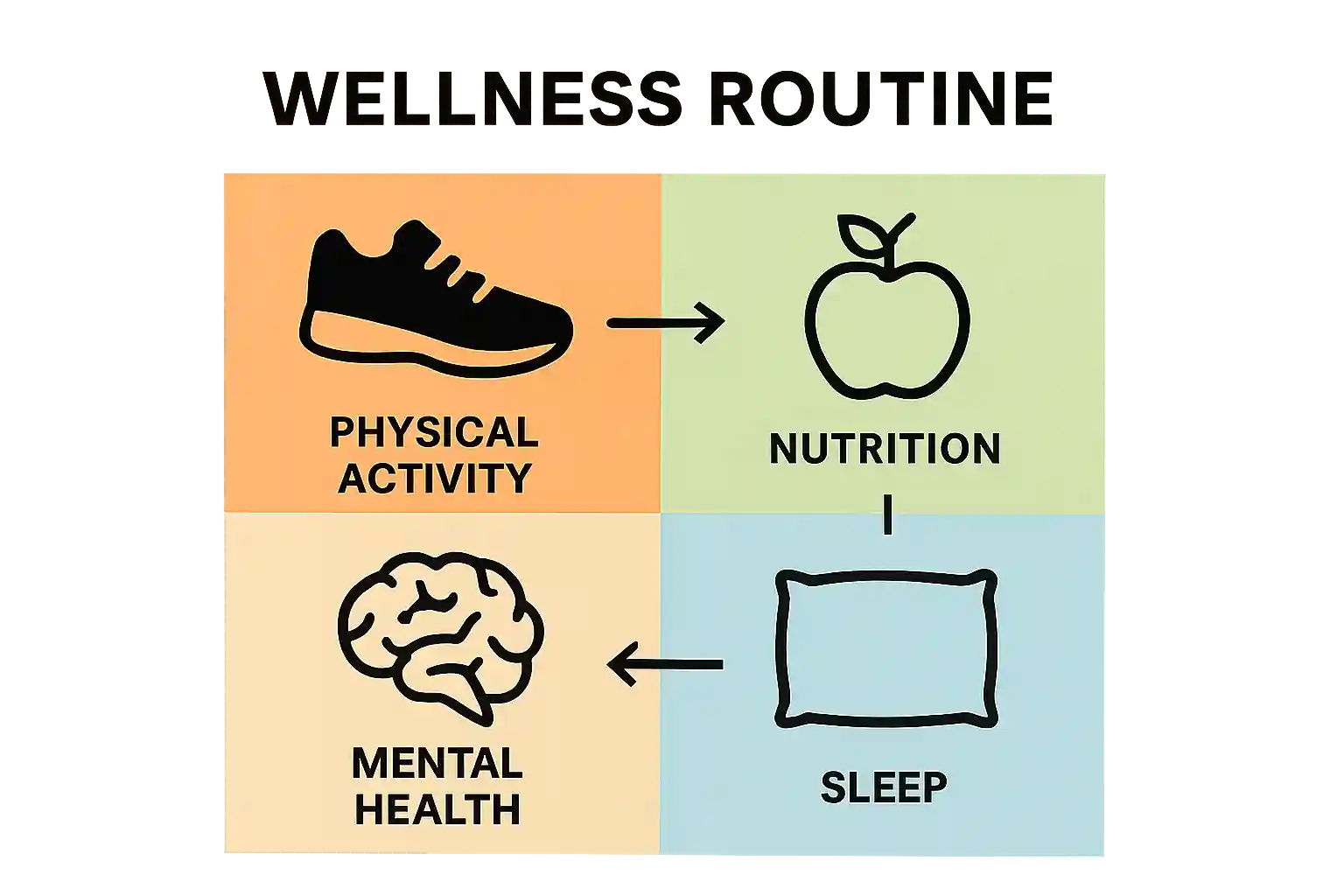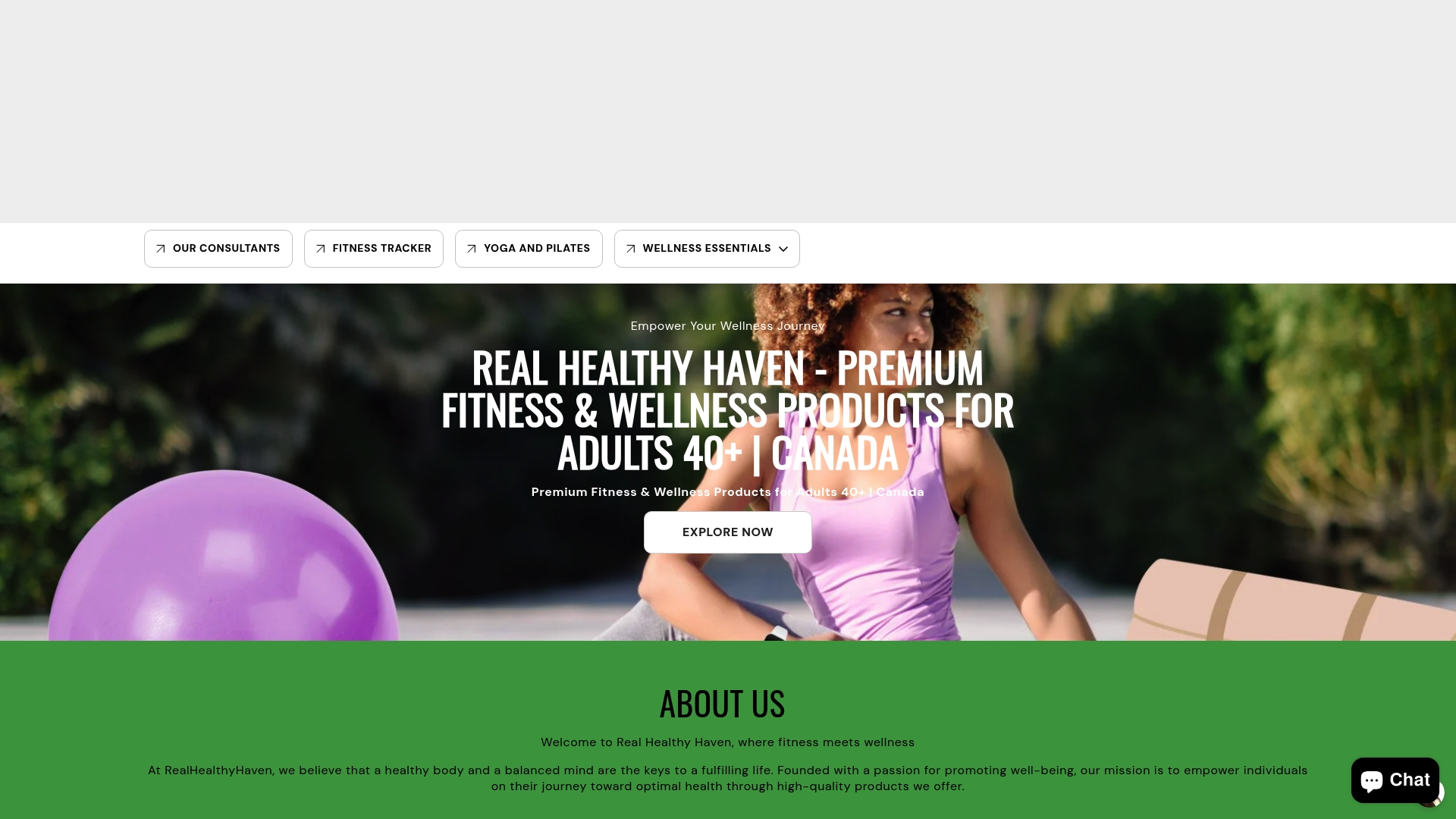Wellness routines are quietly shaping how people over 40 stay sharp and active for decades longer. Most folks think healthy aging just means hitting the gym or swapping salads for fries. But the real secret goes deeper and spans your body, mind, and even your social life. Research shows that personalized wellness routines can cut your risk of chronic disease and keep you feeling independent well into your later years. Curious how a few daily habits can rewrite your entire outlook on aging? Get ready for a wake-up call.
Table of Contents
- What Are Wellness Routines And Their Purpose?
- Why Defining Wellness Routines Is Important For Aging
- How Wellness Routines Affect Physical And Mental Health
- Key Elements Of Effective Wellness Routines
- Real-World Examples Of Wellness Routines For Adults Over 40
Quick Summary
| Takeaway | Explanation |
|---|---|
| Wellness routines need personalization | Tailored wellness strategies are essential to address individual health needs and goals effectively. |
| Integrate physical, mental, and nutritional health | Holistic wellness approaches enhance overall well-being by addressing multiple interconnected health dimensions. |
| Engage in consistent physical activity | Regular exercise helps prevent age-related health decline and maintains physical functionality in older adults. |
| Establish structured daily practices | Routine practices like meditation and balanced nutrition support emotional and cognitive resilience during aging. |
| Embrace small, sustainable lifestyle changes | Practical modifications to daily habits can yield significant long-term health benefits, making wellness manageable and accessible. |
What are Wellness Routines and Their Purpose?
Wellness routines represent strategic, intentional approaches to maintaining and enhancing overall health across physical, mental, and emotional dimensions. Unlike sporadic fitness efforts, defining wellness routines involves creating systematic, personalized practices that support long term well being and quality of life, particularly for adults navigating the aging process.
Understanding the Core Components of Wellness Routines
Effective wellness routines are comprehensive frameworks designed to address multiple interconnected aspects of personal health. These holistic strategies go beyond traditional exercise programs by integrating several critical elements:
To clarify what makes up a comprehensive wellness routine, the table below summarizes the essential components and their key purposes for healthy aging.
| Component | Main Purpose | Example Practice |
|---|---|---|
| Physical Activity | Maintains mobility, strength, and metabolic health | Strength training, walking, stretching |
| Nutrition | Supports immune function and cellular health | Balanced macronutrients, age-appropriate diet |
| Mental Health | Reduces stress and enhances cognitive resilience | Meditation, mental engagement exercises |
| Sleep Management | Optimizes recovery and cellular regeneration | Sleep hygiene strategies, regular sleep times |
- Physical activity tailored to individual capacity and fitness levels
- Nutritional approaches supporting metabolic and immune system health
- Mental health practices that reduce stress and promote cognitive resilience
- Sleep management techniques that optimize recovery and cellular regeneration
According to National Institute on Aging, wellness routines are not one size fits all propositions. They require careful customization based on individual health status, genetic predispositions, lifestyle constraints, and personal wellness objectives.
Holistic Purpose of Wellness Strategies
The primary objective of defining wellness routines extends far beyond mere physical fitness. These intentional practices aim to create a sustainable framework for aging gracefully, maintaining independence, and preserving quality of life. Wellness routines serve multiple interconnected purposes:
- Preventing age related health decline
- Maintaining functional mobility and strength
- Supporting emotional and psychological well being
- Reducing risk of chronic health conditions
Research from the American Journal of Preventive Medicine demonstrates that consistent, well structured wellness routines can significantly mitigate age associated health risks, providing individuals with greater control over their long term health trajectory.
By embracing comprehensive wellness approaches, mature adults can transform their aging experience from a passive process to an active, empowered journey of continuous personal development and health optimization.
Why Defining Wellness Routines is Important for Aging
As individuals progress through later stages of life, the significance of proactively managing personal health becomes increasingly critical. Defining wellness routines emerges as a strategic approach to counteracting natural physiological changes associated with aging, enabling mature adults to maintain functionality, independence, and overall quality of life.
The Biological Impact of Structured Wellness Approaches
Aging triggers complex biological transformations that can significantly impact physical and cognitive performance. Targeted wellness routines act as protective mechanisms against these natural decline processes. Physiological changes such as reduced muscle mass, decreased bone density, slower metabolic rates, and potential cognitive function reduction can be substantially mitigated through systematic health interventions.
- Muscle preservation through resistance training
- Metabolic rate maintenance via consistent exercise
- Cognitive function protection through mental engagement
- Immune system support through nutrition and lifestyle practices
According to Stanford Center on Longevity, implementing comprehensive wellness strategies can potentially delay or minimize age related functional limitations.
Psychological and Social Dimensions of Wellness Routines
Beyond physical health, defining wellness routines plays a profound role in psychological well being. Structured health practices provide psychological benefits that extend far beyond immediate physical outcomes. They create a sense of purpose, control, and continuous personal development during aging.
The following table compares the biological, psychological, and social impacts of wellness routines for aging adults, providing a clear overview of their multidimensional benefits.
| Dimension | Impact on Aging | Example Result |
|---|---|---|
| Biological | Slows physical and cognitive decline | Preserved muscle mass, improved immunity |
| Psychological | Enhances emotional resilience | Reduced anxiety, increased confidence |
| Social | Boosts engagement and well-being | More social activities, better support |
- Reducing anxiety about health decline
- Promoting social engagement through group activities
- Building confidence through achievable health goals
- Creating meaningful daily structures
Research from the American Psychological Association highlights that individuals with consistent wellness routines demonstrate higher levels of life satisfaction, reduced depression risks, and enhanced emotional resilience.
By recognizing wellness routines as comprehensive life strategies rather than mere exercise programs, mature adults can transform their aging experience into an empowering journey of continuous growth and self optimization.
How Wellness Routines Affect Physical and Mental Health
Wellness routines represent a sophisticated, interconnected approach to health that transcends traditional exercise paradigms. By integrating physical activities, nutritional strategies, and mental health practices, these comprehensive approaches create profound transformative effects on both physiological and psychological systems.
Physiological Mechanisms of Wellness Interventions
Cellular level changes occur when consistent wellness routines are implemented, triggering intricate biological responses that support overall health optimization. Physical activities and targeted nutritional approaches stimulate critical bodily processes that counteract age related deterioration.
- Enhanced mitochondrial function and energy production
- Improved hormonal balance and metabolic efficiency
- Reduced systemic inflammation markers
- Accelerated cellular repair mechanisms
Research from National Institutes of Health demonstrates that strategic wellness interventions can significantly modulate genetic expression, potentially slowing cellular aging processes.
Neurological and Psychological Health Connections
Wellness routines create powerful neuroplastic changes that directly impact cognitive function and emotional regulation. Regular mental and physical engagement stimulates neural connections, promotes brain plasticity, and supports robust psychological resilience.
- Increased neurotransmitter production
- Enhanced stress management capabilities
- Improved emotional regulation mechanisms
- Strengthened cognitive processing speed
According to Harvard Medical School, consistent wellness practices can generate measurable improvements in brain structure and function, particularly in regions associated with memory and executive functioning.
By understanding wellness routines as holistic health strategies, mature adults can proactively cultivate comprehensive well being that addresses both physical performance and mental vitality. The synergistic approach ensures a more integrated, resilient approach to personal health management during aging.

Key Elements of Effective Wellness Routines
Creating comprehensive wellness routines requires a nuanced understanding of integrated health strategies that address multiple dimensions of human well being. These sophisticated approaches go beyond simplistic fitness recommendations, demanding personalized, holistic frameworks that adapt to individual physiological and psychological needs.
Personalization and Adaptive Strategies
Individual variability is the cornerstone of effective wellness design. Mature adults require customized approaches that recognize unique health backgrounds, genetic predispositions, lifestyle constraints, and personal fitness capabilities. A one size fits all methodology becomes increasingly inappropriate with age, necessitating highly tailored wellness interventions.
- Assessment of current physical fitness levels
- Comprehensive health history evaluation
- Identification of specific wellness goals
- Recognition of personal mobility limitations
Research from Mayo Clinic emphasizes that personalized wellness strategies dramatically improve long term adherence and health outcomes.
Multidimensional Health Integration
Wellness routines must transcend singular focus areas, creating integrated approaches that simultaneously address physical, nutritional, mental, and emotional health domains.
 Holistic wellness requires comprehensive, interconnected strategies that recognize the complex interactions between different bodily systems.
Holistic wellness requires comprehensive, interconnected strategies that recognize the complex interactions between different bodily systems.
- Physical exercise targeting strength and flexibility
- Nutritional plans supporting metabolic health
- Stress management and mindfulness practices
- Sleep optimization techniques
According to American College of Sports Medicine, effective wellness routines must balance multiple health dimensions to generate meaningful, sustainable improvements.
By understanding wellness routines as dynamic, personalized frameworks, mature adults can develop adaptive strategies that evolve with changing physiological requirements, ensuring continuous health optimization and enhanced quality of life.
Real-World Examples of Wellness Routines for Adults Over 40
Transitioning wellness strategies from theoretical concepts to practical, implementable routines requires understanding contextual applications tailored specifically for mature adults. These real world examples demonstrate how comprehensive health approaches can be seamlessly integrated into daily life, addressing unique physiological and lifestyle considerations.
Lifestyle-Integrated Wellness Approaches
Successful wellness routines blend structured activities with natural lifestyle modifications. For adults over 40, this means creating holistic health strategies that feel organic and sustainable rather than rigid or overwhelming. Strategic wellness integration considers individual preferences, time constraints, and existing physical capabilities.
- Incorporating walking meetings during workday
- Utilizing standing desks or active workstations
- Implementing short, high intensity exercise intervals
- Practicing mindfulness during commute or transition periods
Research from Centers for Disease Control and Prevention indicates that small, consistent lifestyle modifications can produce significant cumulative health benefits for mature adults.
Comprehensive Wellness Routine Frameworks
Effective wellness routines for adults over 40 require multidimensional strategies that simultaneously address physical, nutritional, and mental health domains. These integrated approaches recognize the interconnected nature of holistic well being.
- Morning meditation and stretching routine (20 minutes)
- Balanced nutritional plan with age appropriate macronutrient distribution
- Strength training focusing on functional movement patterns
- Regular health monitoring and preventative screenings
According to American Journal of Preventive Medicine30317-8/fulltext), structured wellness routines significantly reduce chronic disease risks and enhance overall quality of life for aging populations.
By understanding wellness as a dynamic, personalized journey, mature adults can design flexible health strategies that adapt to changing physiological requirements while maintaining engagement and motivation.
Bring Your Wellness Routine to Life with Trusted Solutions
Understanding the importance of a holistic wellness routine is only the first step. Many adults over 40 recognize the need for personalized, multi-dimensional approaches to healthy aging, yet find it difficult to source the right tools that support their physical activity, nutrition, and self-care. If you are striving to maintain your independence, boost your energy, and stay mentally sharp, you deserve real support designed for your unique needs. Discover why so many Canadians trust our range of curated wellness essentials tailored for adults just like you at Real Healthy Haven.

It is time to move from learning to action. Start building your customized wellness routine today by exploring specialized health monitors and fitness equipment that fit seamlessly into your lifestyle. Take charge of your healthy aging journey now. Visit https://realhealthyhaven.com for the latest products, free shipping in Canada, and ongoing expert support.
Frequently Asked Questions
What are wellness routines?
Wellness routines are structured, intentional practices designed to maintain and enhance overall health across physical, mental, and emotional dimensions, particularly for aging adults.
Why are wellness routines important for healthy aging?
Wellness routines help counter the natural physiological changes associated with aging, enabling individuals to maintain functionality, independence, and a better quality of life.
What are the core components of an effective wellness routine?
Effective wellness routines typically include personalized physical activity, nutritional strategies, mental health practices, and sleep management techniques, all tailored to an individual’s unique needs.
How can I personalize my wellness routine?
To personalize your wellness routine, assess your current fitness levels, evaluate your health history, identify specific wellness goals, and recognize your mobility limitations to create an adaptive strategy that suits your individual health background.
